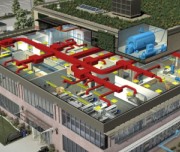Integrative Design Process
The integrative design process understands that buildings, their components, their use and their place and surroundings are interrelated. Whole-building systems observe this principle by involving all stakeholders from project conception through delivery and beyond. Engaging all stakeholders in the design process to create a cross-disciplinary team and using a systems thinking approach helps to identify synergies and benefits that might otherwise go unnoticed, resulting in reduced initial and operating costs and optimizing performance. Submetering considerations include energy and water efficiency, building automation, occupant engagement, and operations and maintenance. Submetering strategies are optimized when coordinated with other building systems, including Lighting, HVAC, Water and IEQ. Submetering can inform water and energy efficiency, as well as occupant comfort and control, measures based on usage.
The integrative design process brings key players to the table to consider and integrate submetering with the systems and operations of the building. Roles and responsibilities should be clearly defined and based on the common objective to maintain and preserve building assets, balance high performance with low operating costs, and achieve a high level of occupant satisfaction. Stakeholders can leverage submetering systems to make smart operational, behavioral, and investments decisions.
Owner
The owner wants to maximize the building's market value and minimize resource use to the level needed to maintain and properly operate the building. Submetering systems help to efficiently manage a building’s resource use, maintaining a high-quality indoor environment while lowering operating costs, resulting in greater operating income. That increase in income also increases the value of the building as an investment, as the worth of a building is often determined by the net present value of future cash flows.

Facility Manager
The facility manager is instrumental in tracking individual building performance data, making data useful for other stakeholders, and taking corrective actions. Submetering systems provide early detection of problems by showing exactly where resource consumption needs to be better managed and highlighting abnormal usage patterns. Evaluating this data requires specific training on energy management and assessment systems. The facility manager develops and implements corrective actions in coordination with operations and maintenance personnel and other team members to improve building performance.

Tenant
The tenant — a representative of the organization that occupies the space — sets expectations for functionality and performance and, through their engagement, affects resource use and IEQ. Submeters at the tenant level allow tenants to benefit from energy conservation practices they implement and eliminate utility billing problems associated with arbitrary ratio-based measures (e.g. square footage) that favor high volume users over low-use tenants. Engaging tenants for their input on building performance goals, including energy and water efficiency, can inform the design of submetering systems. Monitoring energy consumption to reduce costs can create larger behavioral changes that impact a building’s overall performance, like purchasing and using energy efficient appliances and working with operations and maintenance staff to reduce energy use.

Design Professionals
Design professionals, including the architect and interior designer, rely on data for important input to the design process. They can also provide important input on submetering systems to verify design strategies and monitor actual performance. Submetering systems help realize the full benefits of high-performance design features by optimizing equipment operations and maintenance, efficiently managing resources, and increasing occupant awareness and behavior change.

Codes and Standards Developers and Regulators
Codes and standards developers and regulators aim to safeguard public safety by setting minimum requirements for building performance. Submetering can provide codes and standards developers and regulators with actual energy and water usage data for different types of buildings with a high level of detail to validate requirements within existing codes and standards, or identify new approaches to achieve the intended results. By determining how buildings are really performing, a wide range of opportunities for the overall improvement of building operations and maintenance become available.

Portfolio Manager
The portfolio manager is responsible for the overall performance of building operations and the management of projects for an assigned set of properties. Submetering can help the portfolio manager monitor use and performance to ensure consistency in practices, policies, and procedures across many buildings.

Electrical Engineer
The electrical engineer can provide important input on the design and integration of submetering systems to monitor actual performance. Submetering systems help realize the full benefits of high-performance design features by optimizing equipment operations and maintenance, efficiently managing resources, and increasing occupant awareness and behavior change. As more building systems are electrified and as energy generation and storage systems, as well as new demand loads such as electric vehicle charging, are added at the building level, the need for submetering and the electrical engineer’s role in ensuring the adequacy of electrical systems and developing load balancing and energy reduction strategies becomes even more critical.

Mechanical Engineer
The mechanical engineer can provide important input on submetering systems to verify HVAC design strategies and monitor actual performance. Submetering systems help realize the full benefits of high-performance design features by optimizing equipment operations and maintenance, efficiently managing resources, and increasing occupant awareness and behavior change.

Operations and Maintenance Personnel
Operations and maintenance personnel are responsible for properly operating and maintaining building systems and monitoring and optimizing performance. Submetering systems provide early detection of problems by showing exactly where resource consumption needs to be better managed and highlighting abnormal usage patterns. Evaluating this data requires specific training on energy management and assessment systems. Operations and maintenance personnel develop and implement corrective actions in coordination with the facility manager and other team members to improve building performance.


